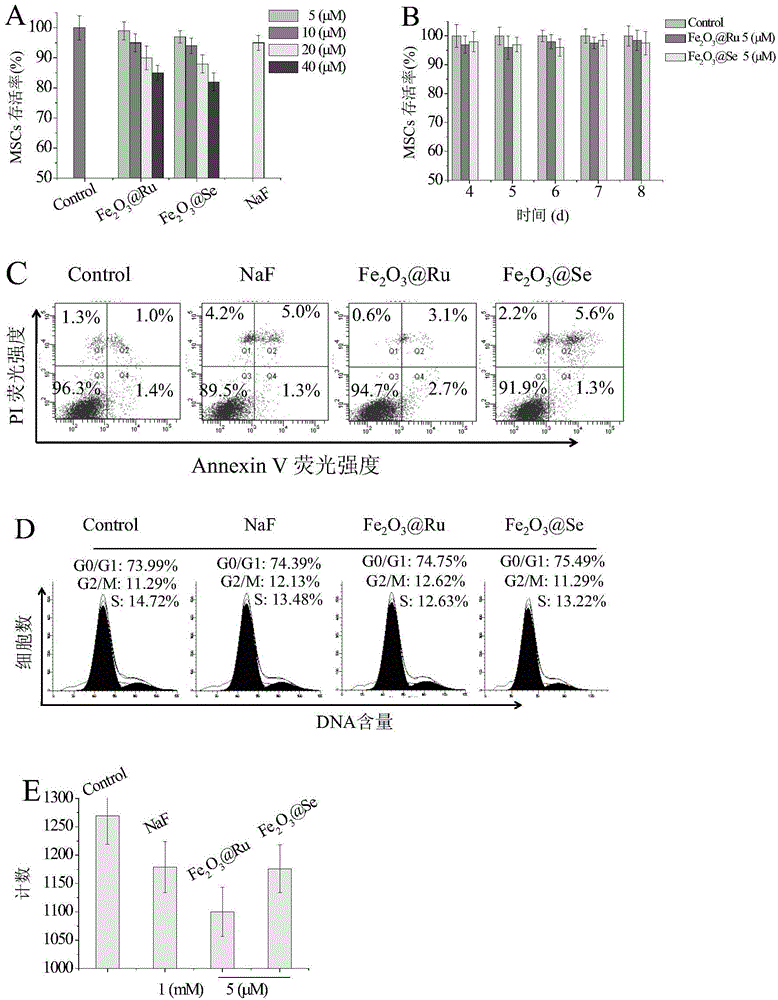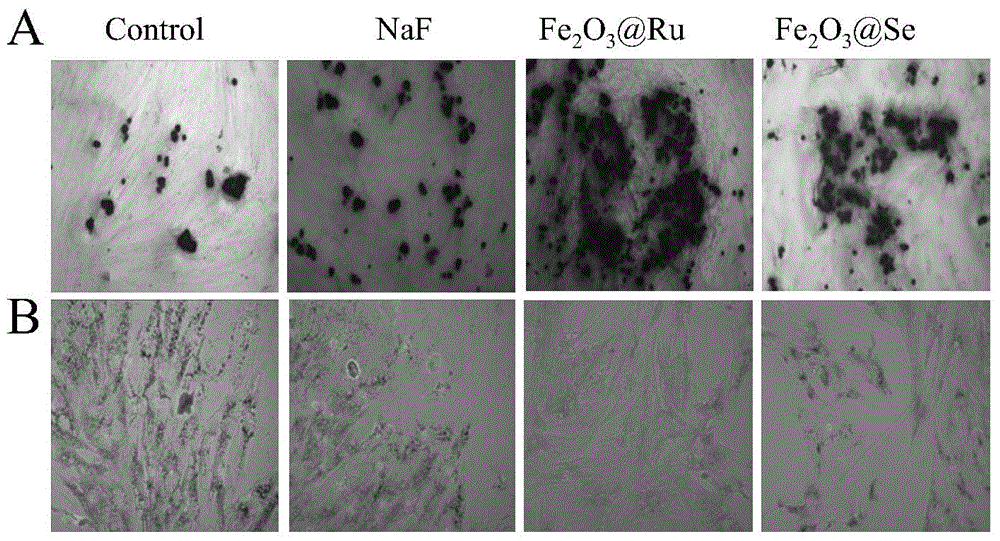Application of magnetic nano materials in promotion of mesenchymal stem cell osteogenic differentiation
A magnetic nano- and stem cell technology, applied in the field of promoting osteogenic differentiation of mesenchymal stem cells, can solve problems such as troubles, and achieve the effects of inhibiting adipogenic differentiation, promoting osteogenic differentiation, and simple product system
- Summary
- Abstract
- Description
- Claims
- Application Information
AI Technical Summary
Problems solved by technology
Method used
Image
Examples
Embodiment 1
[0037] Embodiment 1: the preparation of the nanometer ruthenium of ferric oxide nanometer modification
[0038] 20mg γ-Fe 2 o 3 The nanoparticles were uniformly ground and dispersed in 160mL distilled water, and ultrasonically dispersed in distilled water. After 1 min, at a mechanical stirring speed of 170 r / min, 4 mL of RuCl with a concentration of 0.043 M was added dropwise 3 solution, after the dropwise addition was completed, then add 0.28g of tiopronin. It can be seen that the suspension gradually changes from red to brown. After the reaction was completed, it was washed three times with distilled water under the action of a magnetic field to remove unreacted ions and colloidal ruthenium particles generated. Resuspended in distilled water to obtain Fe 2 o 3Such as suspension. Centrifuge, wash with ultrapure water, and dry the product at 70°C for 2 days to obtain nano-selenium modified with ferric oxide. Observed by TEANAI-10 transmission electron microscope, the r...
Embodiment 2
[0039] Embodiment 2: the preparation of the nano-selenium of ferric oxide nano-modification
[0040] 20mg γ-Fe 2 o 3 The nanoparticles were uniformly ground and dispersed in 160mL distilled water, and ultrasonically dispersed in distilled water. After 1min, under the mechanical stirring speed of 170r / min, add 11.6mg and then add Na 2 SeO 3 , 0.029g tiopronin. It can be seen that the suspension gradually changes from light red to dark red. After the reaction is completed, wash with distilled water three times under the action of a magnetic field to remove unreacted ions and colloidal selenium particles. Resuspended in distilled water to obtain Fe 2 o 3 Se suspension. Centrifuge, wash with ultrapure water, and dry the product at 70°C for 2 days to obtain nano-selenium modified with ferric oxide. Its morphology was observed by TEANAI-10 transmission electron microscope, as shown in figure 1 Shown in B. Its particle size is 160-170nm. The nanoparticles can exist stably...
Embodiment 3
[0041] Example 3: Toxicity detection of magnetic nanomaterials on human umbilical cord mesenchymal stem cells
[0042] In this experiment, human umbilical cord mesenchymal stem cells (MSCs) purchased from ATCC were selected. The sample number tested is: Fe 2 o 3 Ru (nano-ruthenium modified with ferric oxide nanometers), Fe 2 o 3 Se (nano-selenium modified with ferric oxide nanometers) and sodium fluoride.
[0043] (1) MTT test method
[0044] The well-grown third generation human umbilical cord mesenchymal stem cells were taken, and the concentration of living cells was adjusted to 2×10 4 / mL was added to a 96-well culture plate, 100 μL per well, cultured in an incubator for 24 hours, and then added 100 μL of aqueous solutions of magnetic nanomaterials with different concentrations. The negative control was equal volume of normal saline, and the positive control was sodium fluoride. Four replicate wells were set up in both the sample addition group and the control group,...
PUM
| Property | Measurement | Unit |
|---|---|---|
| particle diameter | aaaaa | aaaaa |
Abstract
Description
Claims
Application Information
 Login to View More
Login to View More - R&D
- Intellectual Property
- Life Sciences
- Materials
- Tech Scout
- Unparalleled Data Quality
- Higher Quality Content
- 60% Fewer Hallucinations
Browse by: Latest US Patents, China's latest patents, Technical Efficacy Thesaurus, Application Domain, Technology Topic, Popular Technical Reports.
© 2025 PatSnap. All rights reserved.Legal|Privacy policy|Modern Slavery Act Transparency Statement|Sitemap|About US| Contact US: help@patsnap.com



